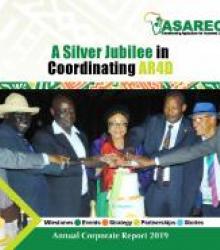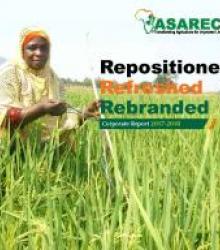| Title | Author | Asbract |
|---|---|---|
| How ASARECAs climbing bean project has improved livelihoods in Rwanda, Burundi and eastern DR Congo | Dr. Vicky Ruganzu | Intensification of Climbing Bean Agro-systems is one of the projects the Association for Strengthening Agricultural Research in Eastern and Central Africa (ASARECA) is funding in Rwanda, Burundi, and eastern DR Congo. This project is crucial because of the importance of beans in the diets of the populations of the three countries. The common bean (Phaseolus vulgaris L) is their primary source of proteins (21%), carbohydrates (60%), minerals (iron, zinc) and vitamins (19%) and other nutrients. The consumption of beans in the project area is estimated to be more than 60 kg per person per year. |
| The Role of Mainstreaming Gender in Agricultural Research and Development | HenryManyire | This paper seeks to highlight one of the major contradictions bedeviling efforts to feed the ECA region in the present times; whereas the gendered management system of food production in particular and agricultural production in general has not changed much over the last century, the bio-physical production system has undergone tremendous change. As a result, there has been increasing demand for food without commensurate increases in food production. Unfortunately, while the deteriorating bio-physical production system that has depressed food production has evidently received research and policy attention, the static gendered management system has received scanty attention. This is because the gendered management system is part of the broader structure of gender relations that are so entrenched in the formal and informal institutions in society that they are treated as givens or natural. Hence, agricultural and social scientists and policy makers rarely recognize the challenges posed by the gendered management system to food production. |
| Payment for environmental services: Laying the ground work | Hezron Mogaka, J. B. Okeyo-Owuor, Anderson Kipkoech | Between 2009-2011 ASARECA supported a consortium of five institutions in three countries, namely, the School of Environmental Studies (Moi University), Kenya Agricultural Research Institute (KARI), and VIRED International ÔÇô all of Kenya; University of Kinshasa & INERA of D. R. Congo; Nature Harness Initiatives and the Environmental Conservation Trust both of Uganda, to conduct research to develop methods for Valuation, Attribution and Compensation for Payments for Environmental Services (VAC-PES) in Eastern and Central Africa. The target research landscapes were the Mt. Elgon Region (Cross boundary between Uganda and Kenya) and the Albertine Rift (between Uganda and DRC). Many other institutions have carried out studies and undertaken PES related activities in other landscapes in Eastern and Central Africa, but the information on these activities occurs in a disjointed manner. The papers presented in this book are an attempt to pool some of this information into one volume. The papers cut across different aspects of Environmental Services (watershed management, carbon sequestration, and biodiversity management), as well as policy and institutional issues related to PES. It is envisaged that this publication will provide information necessary to spur PES programmess in the region. |
| Physiological and biochemical response of tea [Camellia sinensis (L.) O. Kuntze] to water-deficit stress | T. K. Maritimi, S. M. Kamunya, P. Mireji, C. Mwendia, R. C. Muoki, E. K. Cheruiyot and F. N.Wachira | A study to determine the physiological and biochemical responses of eight tea [Camellia sinensis (L.) O. Kuntze] cultivars to water-deficit stress was conducted in a rain-out shelter using potted plants. Three levels of soil moisture content [34, 26, or 18% (v/v) water] were applied to three plants of each cultivar in a complete randomised design, and the whole experiment was replicated three-times. The treatments were applied for 12 weeks, during which time plant water status, shoot extension rates, changes in gas exchange parameters, and leaf proline and glycinebetaine concentrations were determined. The imposition of severe water-deficit conditions [18% (v/v) soil water content] caused a significant (P 0.05) decline in the relative water content of leaves, shoot water potentials, and shoot extension rates from mean values of 84.8% to 50.6%, 0.80 to 1.15MPa, and 1.87 to 0.29 mm d1, respectively, compared to plants grown in a well-watered soil [34% (v/v) soil water content]. The three gas exchange parameters measured (stomatal conductance, evapotranspiration rate, and rate of net photosynthesis) also declined significantly (P Ôëñ 0.05) with decreasing soil moisture content. In contrast, water-deficit stress increased the accumulation of leaf proline and glycinebetaine from mean values of 0.104 to 0.244 mol g1 FW, and from 1.567 to 2.025 mol g1 DW, respectively. The eight tea cultivars differed significantly (P 0.05) in their responses to water-deficit stress. Proline accumulation was significantly (P Ôëñ 0.05) higher in the drought-tolerant cultivars, TRFK 306, TRFCA SFS150, and EPK TN14/3, suggesting that proline concentration could be used as a marker for drought-tolerance in tea. |
| How African Agriculture is under-rated due to narrow notions of evidence | When economists and policy makers in developing countries talk about evidence, in most cases they mean numbers or statistics. For instance in African countries, statistics dominate the language used to describe fiscal policies and budgets in monetary terms. Factors like contribution to GDP, production outputs per hectare and export earnings are all about figures. However, in real life, evidence goes beyond figures or statistics. If developing countries swallow this notion of evidence hook line and sinker, they completely undervalue their economies. |
|
| Scoping Study on Burundi’s Agricultural Production in a Changing Climate and Supporting Polices | The Kenya Institute for Public Policy Research and Analysis (KIPPRA) & UNECA | |
| ASARECA Work on Agro-Biotechnology for Food and Nutrition Security in Eastern and Central Africa | Ben Moses Ilakut | ENTEBBE, UGANDA--ASARECA has highlighted its areas of focus in efforts to promote the benefits of biotechnology for food and nutrition security in Eastern and Central Africa. The key areas include: Follow up initiatives to ensure the technologies developed in past interventions are transferred to the national systems; coordinating the development of physical infrastructure for biotechnology adoption; and coordinating priority setting for biotechnology research among others. |
| Understanding the Recent Food Price Trends in Uganda | Swaibu Mbowa, Joseph Mawejje and Ibrahim Kasirye | The global food price crisis has worsened the food security situation for many developing countries especially those that are net food importers. In September 2012, the United Nations Food and Agriculture Organization (FAO) raised fears of a repeat of the 2007-2008 world food price crisis (as illustrated in Figure 1) that was characterized by sharp increases in the prices for cereals. High food prices are once again threatening to push millions of people into hunger around the world. ( Click to download the file below for the full article) . |
| Increasing Food Prices and Implications on the Ugandan Economy | Swaibu Mbowa, Joseph Mawejje and Ibrahim Kasirye | Since the global food price crisis of 2007/08, the price of major food commodities in Uganda has continued to rise.The price of maize grain, for example increased by 90% - from UGX 400 in 2007 to about UGX 750 per kg in 2008 (Figure 1). In 2010 the price of maize grain reduced to UGX 390 but later hiked by 250% to UGX 1,400 in mid-2011. Since then the price has remained above UGX 1,000 per kg. In case of beans, the retail price reached UGX 1,300 per Kg in 2008, and hit the record high of about UGX 2,500 in the second quarter of 2011 and has remained above UGX 2,000 per kg. (Click to download the file below to read the full article). |
| Facilitating scaling out and spillovers of agricultural technologies and knowledge: Study to inform SIMLESA Volume 1: Main report | ASARECA | The Sustainable Intensification of Maize Legume cropping systems for food security in Eastern and Southern Africa (SIMLESA) programme aims to increase farm-level food security and productivity through developing more resilient, profitable and sustainable farming systems. It is a multi-stakeholder collaborative programme covering five countries Ethiopia, Kenya, Malawi, Mozambique and Tanzania. The programme focuses on validation and delivery of technological and institutional innovations that can significantly change the livelihoods of millions of smallholder farmers in Eastern and Southern Africa (ESA). |
| Facilitating scaling out and spillovers of agricultural technologies and knowledge: Study to inform SIMLESA Volume 2: Annexes | The SIMLESA strategy emphasises leveraging science and technology by using existing scientific evidence to enhance evaluation, adaptation and delivery of profitable options to smallholders. However, for SIMLESA to achieve its overall objective of spreading the impacts of its outputs widely within the five participating countries and beyond, integration of mechanisms that facilitate effective knowledge and technology transfers or spillovers is critical. |
|
| Tanzania Seed Sector Assessment | ASARECA | Participatory National Seed Sector Assessment For The Development Of An Integrated Seed Sector. Development (Issd) Programme In Tanzania Synthesis ReportFINAL DRAFT April 25 2014. Commissioned by the Bill & Melinda Gates Foundation |
| Situation analysis of the current status of tissue culture application in the Eastern and Central Africa region | Clet Wandui Masiga, Emmarold Mneney, Francis Wachira, Charles Mugoya | Plant tissue culture which involves culture of explants on nutrient media under sterile conditions is one of the proven biotechnology applications that has hugely impacted on crop improvement. Notable of these applications have been: micro propagation, germplasm preservation, generation pathogen-free plants, embryo rescue, haploid production and genetic engineering. It suffices to note that the afore mentioned applications in tissue culture are commonplace in other parts of the world, where agricultural production is critical. Basing on the positive contribution of tissue culture in other parts of the world itÔÇÖs adoption and/or application can be useful in the ECA region, where crop production is below optimal owing to severe biotic constraints.
|
| Status of human resource capacity for agricultural innovation in ASARECA national agricultural research systems | ASARECA | The study targeted 6 countries in the ASARECA region: Burundi, Democratic Republic of Congo, Eritrea, Madagascar, Rwanda and south Sudan. Within those countries the target organisations were national agricultural research institutes, agricultural universities (public and private) and private research companies/ institutes where they exist. The study assesses the human and institutional capacity on the ground, looks at the overall environment, including infrastructure that supports research, and makes several conclusions and recommendations. |
| Ethiopia, Kenya, Tanzania and Uganda Use Science and Technology to Boost Agricultural Productivity | ASARECA |
|
Search
Search entail eLibrary collection
Copyright © 2025. All rights reserved.
Designed By ASARECA


